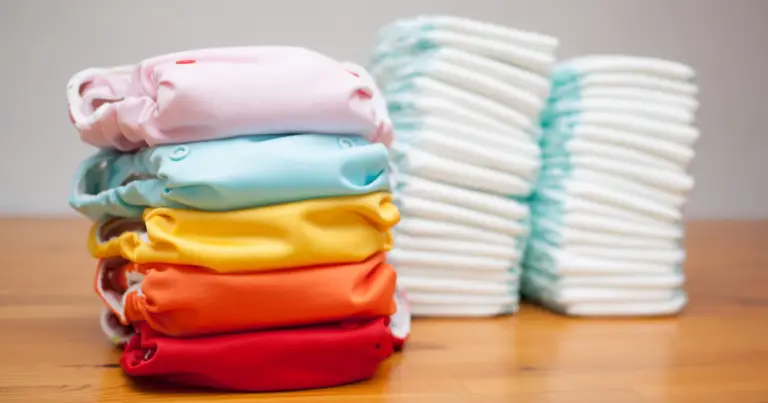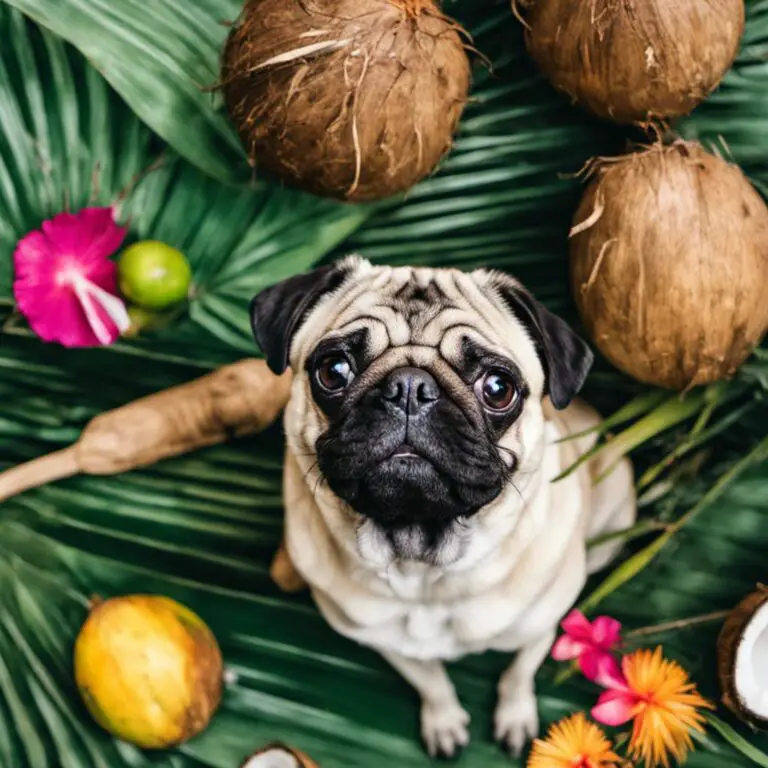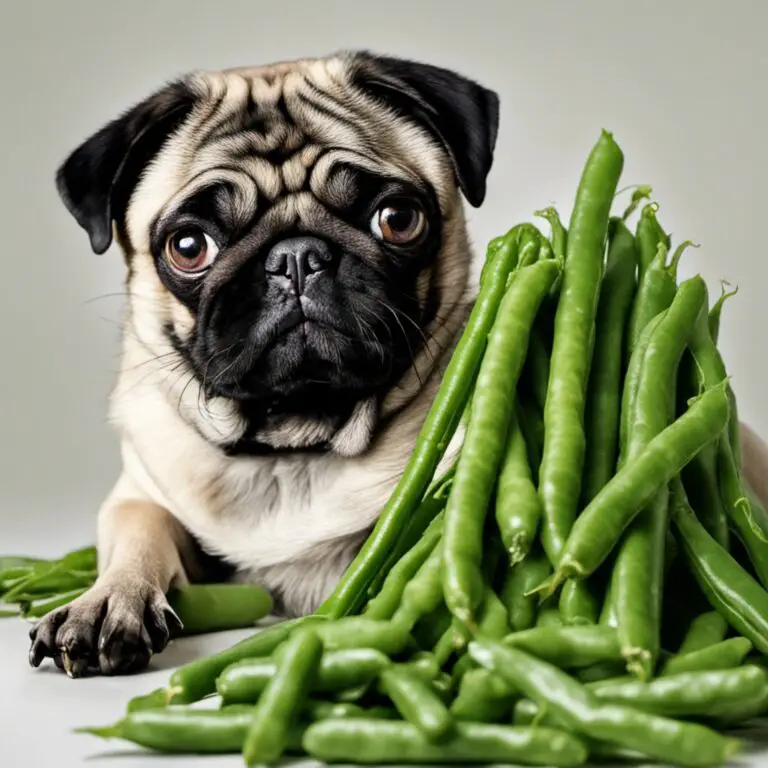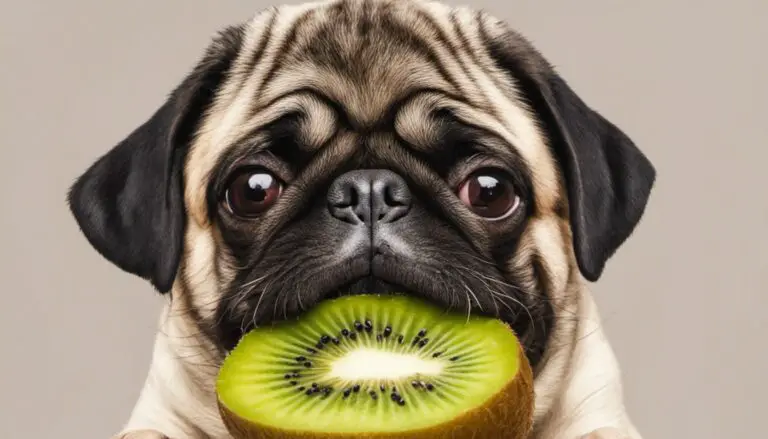Can Pugs Eat Cauliflower? A Nutritional Guide for Pug Owners
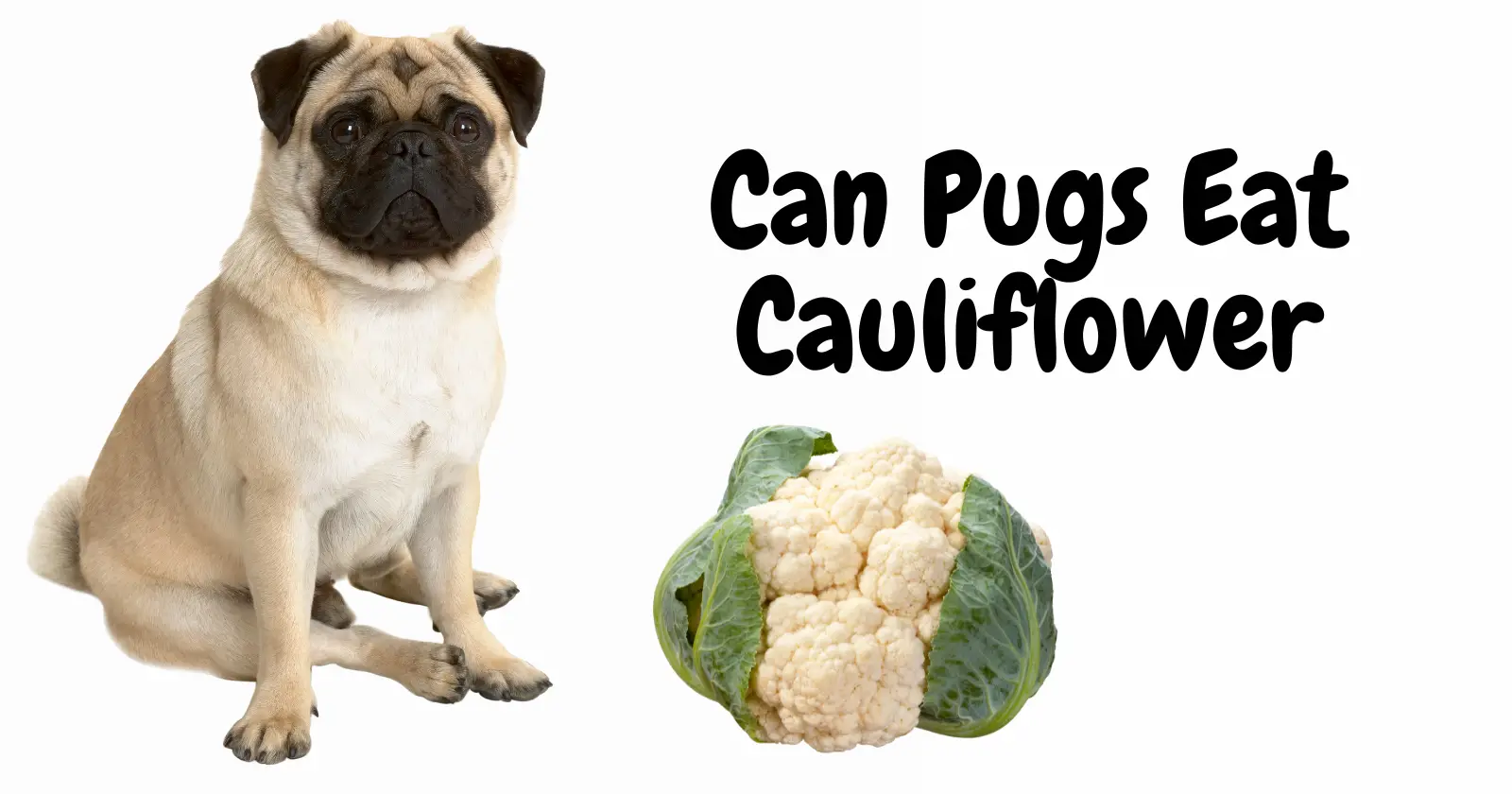
Cauliflower is often praised as a healthy and nutritious vegetable packed with various vitamins and minerals. But as a pug owner, you might wonder if your furry friend can also enjoy the benefits of this veggie. This article will answer the question: can pugs eat cauliflower?
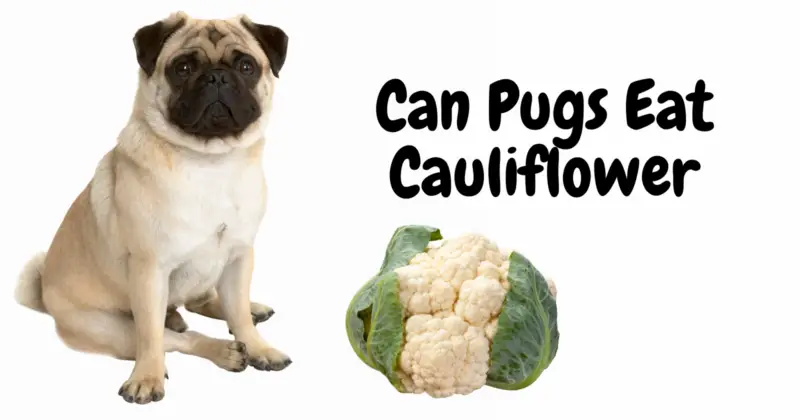
The good news is that pugs can indeed eat cauliflower. In fact, it is a wholesome addition to their diet, providing fiber, vitamins K and C, calcium, potassium, and folate. These nutrients support your pug’s vision, blood, liver, muscles, immune system, and more.
However, it’s essential to ensure that any cauliflower you feed to your pug is served plain, either in raw form or cooked without any salt, butter, or spices, as some ingredients added to cauliflower dishes can be toxic for dogs.
As with any new food, it’s important to introduce cauliflower gradually and in small amounts to your pug’s diet. This will help ensure that there are no adverse reactions or digestive issues. So, go ahead and treat your pug to some healthy cauliflower, knowing that it can be a beneficial addition to their meals.
Contents
Get The Free Food Eating Guide That Keeps My Pug Happy and Playful Even at 13 Years Old
100% Beginner Friendly & Lists Real Foods Your Pug Can Actually Eat!

Table of Contents
The Pugs Diet: Can Pugs Eat Cauliflower
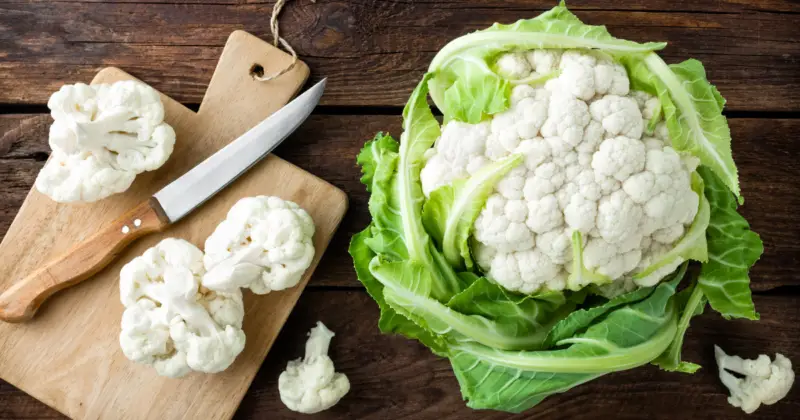
Cauliflower can be a healthy addition to a pug’s diet. This vegetable is known for its numerous health benefits, including compounds that may reduce the risks of cancer and heart disease source. A well-rounded diet for pugs can include various types of nutritious vegetables and fruits in addition to their regular dog food.
Dogs, like pugs, can enjoy a variety of vegetables in their diet, such as boiled potatoes, spinach, peas, kale, cauliflower, and green beans source. These vegetables provide essential vitamins and minerals that can contribute to overall health and well-being. However, it is essential to feed them in moderation to ensure a balance in their diet.
Incorporating healthy treats into a pug’s diet can be a delightful way to reward them and provide extra nutrients at the same time. Homemade or raw food treats can include fruits such as apples, blueberries, watermelon, and vegetables like carrots and broccoli. It’s important to avoid feeding pugs any type of alliums or bulb vegetables like onions, garlic, and chives, as they are toxic to dogs and can cause organ damage source.
In summary, ensuring that your pug gets a well-rounded diet means providing a combination of healthy dog food, vegetables, and fruits, which can include cauliflower as a nutritious option. Offering these foods in moderation will help maintain a proper balance in their diet and contribute to their overall health and happiness. Remember always to consult your veterinarian for any specific dietary recommendations for your pug.
Understanding Cauliflower for Dogs
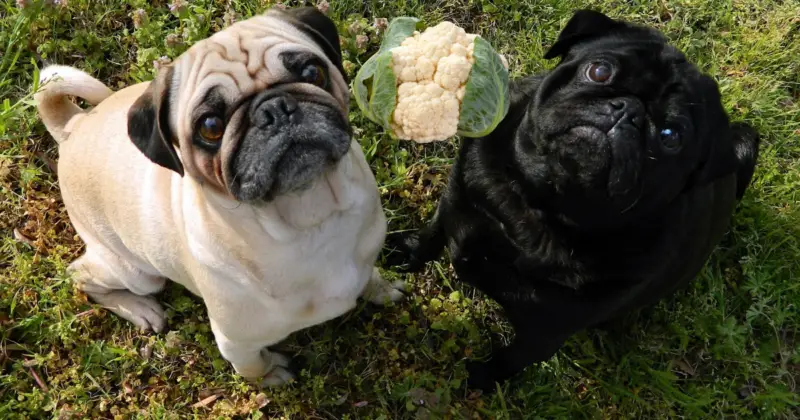
Cauliflower is a healthy vegetable that dogs can safely consume, including pugs. This cruciferous vegetable is packed with various nutrients, such as vitamins, antioxidants, and minerals, making it a wholesome addition to your dog’s diet.
Rich in vitamin C, vitamin K, vitamin B6, potassium, and manganese, cauliflower boasts numerous health benefits for dogs. Vitamin C strengthens the immune system, while vitamin K plays a crucial role in blood clotting and bone metabolism. Vitamin B6 supports healthy brain function, and potassium helps regulate fluid balance in the body. Manganese, on the other hand, aids in the formation of bones, cartilage, and connective tissues.
One of the key nutrients in cauliflower is its high fiber content. Fiber has multiple benefits, including promoting colon health, aiding in weight management, and addressing bowel issues. Another critical attribute of cauliflower is its high water content. Hydration is essential for dogs, as it supports their overall well-being and helps eliminate waste and toxins from their body.
Cauliflower is also known for its antioxidant properties, which can help protect your pet’s cells from oxidative stress and minimize inflammation. These antioxidants are essential for maintaining optimal health, boosting your dog’s immune system, and keeping their organs functioning efficiently.
While cauliflower can be a beneficial addition to your pug’s diet, it’s essential to serve it in moderation and in a suitable form to prevent choking hazards. You can feed cauliflower to your dog in small, bite-sized pieces, or even as riced cauliflower. It can be served frozen, raw, or cooked without added seasonings; however, it’s best to avoid giving them large or whole pieces that could cause choking.
In summary, incorporating cauliflower into your dog’s diet provides them with essential nutrients and antioxidants while also promoting healthy digestion and weight management.
Can Pugs Eat Cauliflower? Watch this
Is Cauliflower Safe for Pugs?
Cauliflower is indeed safe for Pugs to consume as part of their diet. This healthy vegetable is rich in folate, potassium, fiber, calcium, and vitamins K and C, making it a beneficial food for pugs. However, when serving cauliflower to your Pug, it is important to keep moderation in mind.
Although cauliflower is not toxic to dogs, feeding them excessive amounts can lead to digestive issues, such as gas or an upset stomach. As a guide, a small dog like a Pug should not be fed more than 1-2 small florets daily. Preferably, serve the cauliflower raw, as it retains more nutrients in its uncooked state.
However, it might be a good idea to steam it if you’re concerned about gas. Be sure to introduce the vegetables slowly into your Pug’s diet to assess their tolerance.
Cauliflower can be a great addition to your Pug’s diet as a dog treat, especially when trying to provide a healthy alternative to traditional store-bought dog treats. Since cauliflower is low in calories and high in nutrients, it can be a guilt-free option for rewarding your Pug’s good behavior or as a simple snack.
When incorporating cauliflower as a treat, be mindful of any allergies or sensitivities your Pug may have. If you notice any discomfort after feeding cauliflower to your Pug, consult your veterinarian for advice.
In summary, cauliflower is a safe and healthy snack option for Pugs when fed in moderation. While not an essential food item, it can be a nutritious addition to their regular diet or a wholesome dog treat.
Health Benefits of Cauliflower for Pugs
Cauliflower is a healthy and nutritious vegetable that can provide numerous benefits to pugs. One of the key advantages of this vegetable is that it is low in calories, making it an ideal snack choice for pugs who may be prone to obesity.
This cruciferous vegetable is known to be rich in essential vitamins and minerals, which are crucial for maintaining a pug’s overall health. For instance, cauliflower contains vitamins C and K, which are important for supporting the dog’s immune system, skin, and coat health. In addition, the potassium found in cauliflower can contribute to a healthy heart and may help to reduce the risk of heart disease.
When incorporating cauliflower into a pug’s diet, it is essential to consider proper cooking methods. Steaming or boiling the cauliflower will make it easier for your pug to digest without compromising the vegetable’s nutritional value. It’s also important to note that dogs can experience gas and gastrointestinal discomfort if fed large amounts of cauliflower, as it is high in fiber.
In conclusion, incorporating cauliflower into a pug’s diet can provide several health benefits related to its immune system, heart, skin, and coat. This low-calorie vegetable is a suitable snack choice, but make sure to cook it properly and serve it in moderation for optimal digestion and nutrient absorption.
Cauliflower: Raw Or Cooked

Cauliflower can be a nutritious addition to your pug’s diet, but it’s essential to know whether serving it raw or cooked is the best option. Both raw and cooked cauliflower can be given to pugs, but there are some factors to consider before making a decision.
Raw cauliflower is packed with beneficial nutrients and can be a lower-calorie substitute for traditional dog treats. However, some dogs might experience intestinal distress when consuming raw vegetables, as their digestive systems might not process them as efficiently. To minimize this risk, serving cooked cauliflower instead of raw cauliflower to pugs is often recommended.
Cooking cauliflower can make it easier for your pug to digest and process the vegetable, reducing digestive distress. Steaming is a popular method for cooking cauliflower for pugs, as it retains a significant portion of its nutrients during cooking. When cooking cauliflower for your pug, it’s important to avoid adding salt, butter, or seasonings with garlic and onion, which can be harmful to dogs.
When serving cooked cauliflower to your pug, ensure it has cooled to room temperature to avoid any heat-related injuries. You can also cut the cooked cauliflower into smaller, bite-sized pieces, which will make it easier for your pug to chew and swallow.
In conclusion, raw and cooked cauliflower can benefit your pug’s diet. However, serving cooked cauliflower over raw cauliflower is generally recommended due to the potential digestive distress raw vegetables can cause in some dogs.
The Effects of Cauliflower on Pugs Digestion
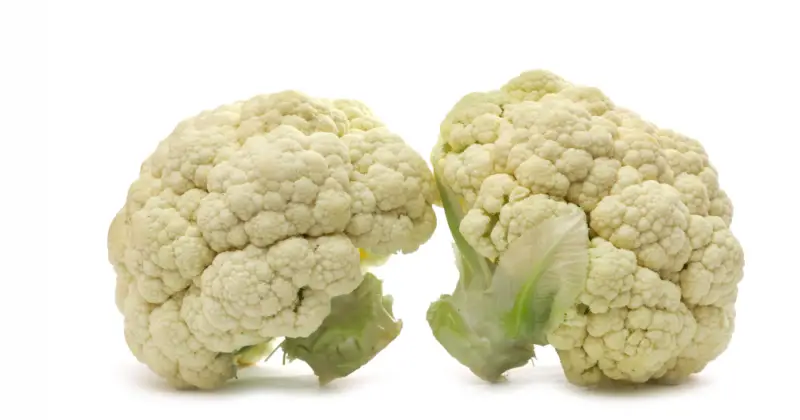
Cauliflower can be a healthy and low-calorie treat for pugs when given in moderation. However, it is essential to understand how it may affect their digestion. Consuming too much cauliflower can cause digestive issues like excess gas, diarrhea, or vomiting in pugs1. To avert these unpleasant effects, monitoring the amount of cauliflower your pug consumes is crucial.
When introducing cauliflower into your pug’s diet, it is vital to do so gradually and always keep an eye on their digestive responses. Offering steamed or boiled cauliflower can help prevent digestive problems as raw cauliflower tends to be difficult for dogs to digest2. Furthermore, making sure it is soft and easily mashable also assists in preventing digestion-related discomforts.
It is important to serve plain cauliflower without added seasonings, oils, or spices, as these can negatively impact your pug’s health3. Some ingredients, like garlic and onion, which are commonly used to flavor cauliflower, are toxic to dogs and should never be fed to them4.
While cauliflower is generally safe for pugs to consume, being mindful of portion sizes and preparation methods can help maintain a healthy and happy pug without unnecessary gastrointestinal issues.
How to Incorporate Cauliflower in a Pug’s Diet

Cauliflower can be a healthy addition to your Pug’s diet, as it is a good source of fiber, vitamins K, vitamin C, calcium, potassium, and folate. These nutrients support your dog’s vision, blood, liver, muscles, and immune system1.
To introduce cauliflower to your Pug, start by offering small amounts, either raw or cooked, and without any added salt, butter, or harmful ingredients like garlic and onion2. Testing whether your Pug enjoys the taste and tolerates the vegetable well is important.
Some ways to incorporate cauliflower into your Pug’s diet include:
- Chopped Cauliflower: Chop the cauliflower into small bite-sized pieces and incorporate them into your Pug’s meal. This can be a good way to encourage them to eat healthier veggies.
- Cauliflower Rice: Grate or finely chop the cauliflower to create a rice-like texture. Mixing this into your Pug’s regular food can subtly introduce the vegetable without overwhelming their taste buds.
- Steamed Cauliflower: Steam the cauliflower until it is soft but not too mushy. This makes it easier for your Pug to chew and digest. Serve the steamed cauliflower alongside your Pug’s usual food.
When introducing cauliflower, always remember moderation is key. Treats and new additions to your Pug’s diet should make up no more than 10% of their daily caloric intake3. As with any change in your dog’s diet, monitor for any adverse reactions or digestive issues and consult with your veterinarian if you notice any concerns.
Other Safe Vegetables for Pugs
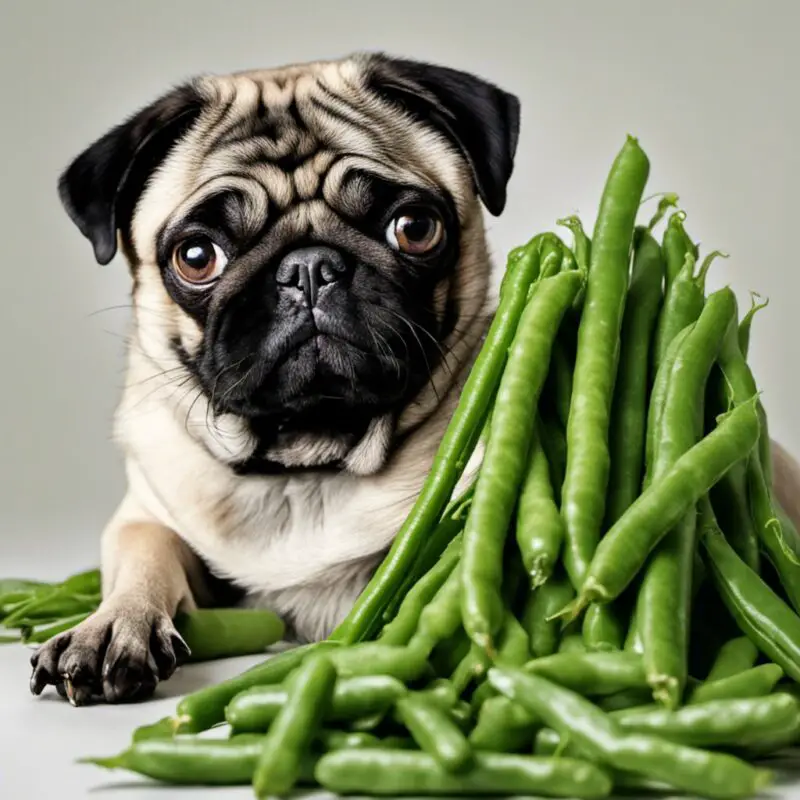
Apart from cauliflower, which has numerous health benefits, there are several other vegetables that can be safely fed to pugs. These vegetables provide essential nutrients and can be a great addition to your pug’s diet.
Carrots are a popular choice for pugs as they are low in calories and high in fiber and beta-carotene. Chewing on carrots can also help promote dental health. It’s best to feed your pug small pieces of carrot to avoid choking hazards.
Green beans make for an excellent low-calorie treat for pugs. They are rich in vitamins and minerals, such as vitamin C, vitamin K, and manganese. Pugs can safely consume cooked or raw green beans. However, ensure that the green beans have no added salt or seasonings.
Zucchini is another healthy option you can add to your pug’s diet. This vegetable is low in calories and packed with vitamins and minerals like vitamin C, potassium, and magnesium. Zucchini can be fed either cooked or raw, but make sure to chop it into small pieces for easier digestion.
Sweet potatoes provide a good dietary fiber, vitamins, and minerals source. They are particularly rich in beta-carotene, which benefits your pug’s eye health. It is essential to cook and serve sweet potatoes without any seasoning or added sugar.
Cucumbers are a hydrating and low-calorie treat suitable for pugs. They contain vitamin K, potassium, and antioxidants, promoting overall health. Feeding your pug small pieces of cucumber without the skin is best to ensure easier digestion.
Finally, green peppers can be a crunchy and refreshing snack for your pug. They are high in vitamins A and C, which can boost the immune system. Be sure to remove the seeds and cut the pepper into small, manageable pieces before feeding it to your pug.
Always introduce new vegetables gradually and in moderation to avoid digestive issues. Don’t hesitate to consult your veterinarian if you have any concerns about your pug’s diet.
Unsafe Foods for Pugs

While cauliflower is considered a safe and healthy option for pugs, there are multiple other foods that can be harmful to them. It is crucial for pug owners to be aware of these dangerous foods to prevent any health complications.
Onions and Garlic: Both onions and garlic are toxic to dogs, especially pugs. They contain compounds called thiosulfates, which can damage your pug’s red blood cells, causing anemia. Small amounts of onion or garlic might not cause severe symptoms, but it is better to avoid feeding them to your pug altogether.
Grapes and Raisins: Grapes and raisins are highly toxic to dogs, including pugs, and can lead to kidney failure. Even a small amount can be dangerous, so keeping them out of your pug’s reach is crucial.
Avocado: Avocados contain a toxin called persin, which can be harmful to dogs. While persin is not dangerous in small amounts, large quantities can cause vomiting, diarrhea, and heart issues in pugs. It is best to avoid feeding them avocado.
Mushrooms: Certain wild mushrooms can be toxic to dogs. To be safe, avoiding giving mushrooms to your pug is recommended, as it can be difficult to distinguish between safe and toxic varieties.
Tomatoes: Unripe tomatoes and tomato plant leaves contain a toxin called solanine, which can harm pugs. Although ripe tomatoes are less of a concern, it is better to err on the side of caution and avoid giving your pug tomatoes.
Cholesterol: High-cholesterol foods should be avoided for pugs, as they can lead to obesity and heart issues. Stick to lean proteins and low-fat options when providing treats or meals for your pug.
Sugar: Excessive sugar intake can lead to obesity, dental issues, and diabetes in dogs. Keep sugary treats to a minimum and opt for healthier, natural options instead.
By being aware of these unsafe foods and ensuring your pug does not consume them, you can help your furry friend maintain optimal health and avoid potential health risks.
Consulting a Veterinarian

When it comes to feeding your pug cauliflower, it is always best to consult with a veterinarian first. Since every dog is unique, your veterinarian can provide personalized dietary advice based on your pug’s specific needs, age, weight, and overall health.
Cauliflower is generally safe for dogs to consume, but introducing it to your pug’s diet should be done with caution. A veterinarian can guide you on the appropriate serving size and frequency, taking into consideration other aspects of your pug’s nutrition. They can also advise you on potential risks, such as gastrointestinal issues if your pug has a sensitive stomach.
It is important to note that while cauliflower is not toxic for dogs, some parts of the vegetable might be more challenging for your pug to digest. For instance, the stems of the cauliflower are fibrous, and it is generally not recommended to feed them to dogs without proper preparation. A veterinarian can suggest the best way to prepare cauliflower for your pug, such as chopping and cooking the stems and leaves to make them softer and more digestible.
If your pug shows any symptoms after consuming cauliflower, such as lack of appetite, vomiting, or pain, it is crucial to contact your veterinarian as soon as possible. Symptoms typically appear within 4 to 24 hours; early intervention can prevent more serious complications.
In conclusion, consulting a veterinarian is essential in determining if cauliflower suits your pug’s diet. By seeking professional advice, you can ensure that your pug receives a well-balanced, nutritious meal plan tailored to their specific needs.
FAQs: Can Pugs Eat Cauliflower

Is it safe for pugs to consume cauliflower?
Yes, it is safe for pugs to consume cauliflower. Cauliflower is an extremely healthy vegetable that can be safely included in a pug’s diet. However, always ensure that you introduce any new food to your pug’s diet gradually and in moderation.
What’s the recommended serving size of cauliflower for pugs?
The recommended serving size can vary depending on your pug’s size, age, and activity level. Start by offering a small amount, such as a teaspoon or tablespoon, and gradually increase the portion if your pug tolerates it well. Always consult your veterinarian for personalized recommendations based on your pug’s specific needs.
Can pugs eat both cooked and raw cauliflower?
Pugs can eat both cooked and raw cauliflower. However, cooked cauliflower is generally easier for pugs to digest and may cause fewer issues when introducing it to their diet. Be cautious when preparing the cauliflower—avoid using excess oils, spices, or salt as these can be harmful to your pug.
Are cauliflower leaves suitable for pugs?
Cauliflower leaves are safe and suitable for pugs to consume. They offer similar nutritional benefits as the cauliflower florets. Just ensure that you clean the leaves thoroughly and remove any wilting or damaged parts.
What benefits does cauliflower provide for pugs?
Cauliflower is high in fiber, which can benefit your pug’s digestive tract and reduce constipation and diarrhea. Additionally, cauliflower contains compounds that reduce the risks of cancer and heart disease.
Are there any vegetables dogs should avoid?
There are some vegetables dogs should avoid, such as onions, garlic, avocado, and raw potatoes. These vegetables can be toxic or harmful to dogs, causing adverse reactions when consumed. Always consult with a veterinarian when introducing a new food item to your dog’s diet to ensure its safety.

